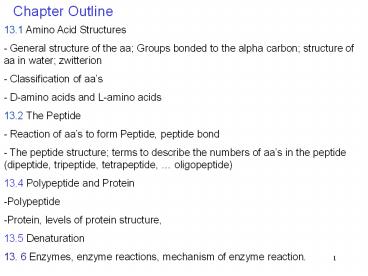Chapter Outline - PowerPoint PPT Presentation
Title: Chapter Outline
1
Chapter Outline
- 13.1 Amino Acid Structures
- General structure of the aa Groups bonded to
the alpha carbon structure of aa in water
zwitterion - Classification of aas
- D-amino acids and L-amino acids
- 13.2 The Peptide
- Reaction of aas to form Peptide, peptide bond
- The peptide structure terms to describe the
numbers of aas in the peptide (dipeptide,
tripeptide, tetrapeptide, oligopeptide) - 13.4 Polypeptide and Protein
- Polypeptide
- Protein, levels of protein structure,
- 13.5 Denaturation
- 13. 6 Enzymes, enzyme reactions, mechanism of
enzyme reaction.
2
13.1 Structures of Amino Acids (aas)
All aas have this general structure, except the
side chains are different. You need to know the
general structure of the aa, but not the side
chain structure of each specific aa.
What is the name of each group or atom bonded to
the alpha C?
3
In water the aa exists as a dipolar ion called
Zwitter ion. All aas behave like this way.
4
(No Transcript)
5
Classifying Amino Acids
- The water solubility and the chemistry of amino
acids vary to some extent, depending on the
makeup of the side chain. - It is useful to use side chains to classify each
amino acid as being either - 1) nonpolar
- 2) polar-acidic
- 3) polar-basic
- 4) polar-neutral.
6
Classifying Amino Acids
- 1) nonpolar - the side chain is usually an alkyl
group, an aromatic ring, or a nonpolar collection
of atoms. - 2) polar-acidic - the side chain contains a
carboxyl group. At pH 7, the carboxyl group is
found in its conjugate base form (-COO-), which
means that the side chain carries a negative
charge at this pH. - 3) polar-basic - the side chain contains an amine
group. At pH 7 the amines exist in their
conjugate acid form and therefore carry a
positive charge at this pH. - 4) polar-neutral - the side chain is usually an
alcohol, a phenol, or an amine. They do not
carry a charge at - pH 7.
7
Stereoisomers (remember what enantiomers are?)
What is one purpose of amino acids?
8
Peptide bond formation
H2O
This bigger molecule is called a Pepetide.
Which bond is the amide bond? Or peptide bond?
Can you find it?
9
Dipeptide, tripeptide, oligopeptide
Ala-Gly
Ala-Gly-Ser
C-terminus
N-terminus
Ala-Gly-Ser-Val-Gly
10
Examples of two real peptides in our bodies.
11
13.4 Protein Structure
backbone
What is a polypeptide?
12
1) Fibrous proteins - These proteins exist as
long fibers or strings. These proteins including
collagen (in skin) and keratin (in hair), are
usually tough and water insoluble.2) Globular
proteins - These proteins are spherical in shape,
highly folded, and tend to be water soluble.
Protein
13
The structure of proteins is understood in terms
of four levels of organization1) primary (the
aa sequence)2) secondary3) tertiary4)
quaternary
Protein Structure
14
Secondary Structure The a-helix.
15
Secondary Structure The b-sheet parallel
b-sheet and anti-parallel b-sheet.
16
Secondary structures compare to tertiary
structure
Tertiary structure
17
Another look at tertiray structure.
Where are the aas in the protein above? What
are we looking at?
18
Non-covalent interactions and S-S- bond
important for maintaining the protein
structure (Can you name each one?)
19
Tertiary Structure
- The tertiary structure refers to the overall
three-dimensional shape of a protein, including
the folding of the ?-helices or ?-sheets with
respect to one another. - Of the many folding patterns (conformations)
possible for a protein, there is usually only one
that leads to a native (biologically active)
molecule. - The sequence of amino acids (primary structure)
ultimately determines which folding pattern is
selected, so both secondary and tertiary
structure depend on primary structure.
20
Tertiary Structure
- In an aqueous environment, the native form of a
globular protein typically has its nonpolar amino
acid side chains folded into the hydrophobic
interior and its polar side chains on the
hydrophilic surface. - This folding rule, known as nonpolar in, polar
out is the most stable arrangement because it
allows polar side chains on the surface of the
protein to interact with water molecules and
allows nonpolar side chains to avoid water.
21
Quarternary Structure of protein
22
13.5 Denaturation
- Denaturation is any change in protein
conformation caused by disruption of the
noncovalent forces responsible for maintaining
the native conformation. - A loss of biological activity normally
accompanies denaturation, and this process is
reversible only if minor changes in conformation
take place.
Denaturation can be caused by heat,
denaturants, extreme pH, sonication, dehydration,
23
(No Transcript)
24
13.6 Enzymes
(Enzyme catalysis)
- Enzymes are often referred to as biological
catalysts. - Most enzymes are globular proteins.
Model of enzyme catalysis.
25
Examples of some real enzyme catalyzed reactions
How does maltase cut (hydrolyze) maltose?
26
Examples of other enzyme catalyzed reactions.
27
Real catalytic mechanism of reaction of maltase
How does maltase cut (hydrolyze) maltose? (This
is exactly how !)
28
Enzyme Inhibition
29
(No Transcript)































